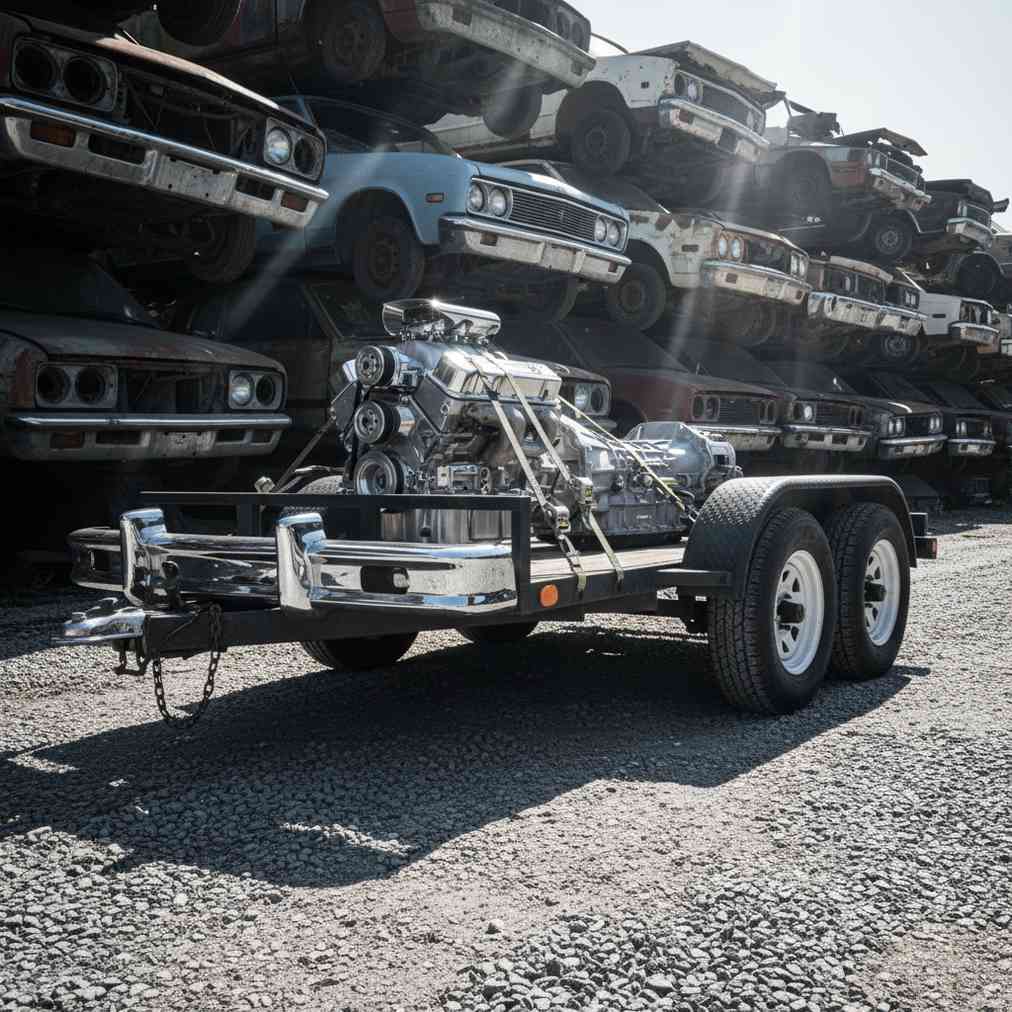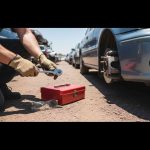Understanding Vehicle and Trailer Policies at Auto Salvage Yards
When planning to transport parts from salvage yards, understanding facility policies is crucial for a successful visit. Most U-Pull-It yards and self-service auto salvage facilities welcome customers bringing their own vehicles and trailers, but specific rules vary significantly between locations. The entire premise of self-service yards is that customers remove and haul their own parts, making personal transportation essential.
Before visiting any junkyard near you, it’s important to understand that policies are highly dependent on individual facility rules, safety protocols, and local regulations. There is no universal standard, but several common themes emerge regarding customer transport vehicles and trailers.
Key Policies for Bringing Your Own Vehicle or Trailer
General Acceptance and Restrictions
Most salvage yards permit personal vehicles and trailers for part transport, but with important limitations:
- Size and weight restrictions to protect yard property and ensure safety
- Designated parking areas only – no parking outside marked zones
- Prohibition on using yard equipment for personal hauling needs
- Time limits may apply to prevent yard congestion
- Insurance verification increasingly required for liability protection
Entry Requirements and Security Measures
Modern salvage yards enforce strict security protocols:
- Photo ID required – customers must be 18 years or older
- Liability waivers must be signed before entry
- Tool and bag inspections upon exit are standard
- Prohibition on bringing personal parts into the yard without pre-approval
- Vehicle registration may be required for trailers on-site
Loading Zones and Parking Protocols
Designated loading areas are typically provided near yard entrances for customers with trailers. These zones are designed for active loading and unloading with specific time limits and safety requirements.
| Loading Zone Feature | Typical Requirements |
|---|---|
| Parking Duration | Active loading only, usually 30-60 minutes |
| Vehicle Size Limits | Varies by facility, typically under 40 feet combined |
| Safety Equipment | Wheel chocks, proper tie-downs required |
| Assistance Available | Staff help for heavy parts (engines, transmissions) |
Vehicle Weight Restrictions and DOT Compliance
While salvage yards focus on their property rules, customers must also comply with Department of Transportation (DOT) regulations when transporting loaded trailers on public roads.
Federal and State Weight Limits
- Federal gross vehicle weight limit: Generally 80,000 pounds for commercial haulers
- Single axle limits: Typically 20,000 pounds maximum
- State variations: California limits single axles to 18,000 lbs on highways
- Pennsylvania regulations: 80,000 lbs gross weight maximum with specific axle spacing requirements
Understanding these regulations is crucial, as exceeding weight limits can result in significant fines and safety hazards. For detailed information about vehicle towing and storage regulations, particularly in California, reference the San Diego Police Department’s towing rights guide.
Best Practices for Successful Part Transport
Pre-Visit Preparation
- Call ahead to confirm trailer policies and size restrictions
- Verify your vehicle’s towing capacity and trailer ratings
- Gather required documentation: ID, vehicle registration, insurance proof
- Prepare proper equipment: tie-downs, straps, wheel chocks
On-Site Safety Protocols
Safety is paramount when using personal vehicles and trailers at salvage yards:
- Park only in designated customer areas to avoid operational disruption
- Engage trailer brakes and use wheel chocks during part removal
- Load heavy parts first and distribute weight evenly
- Secure all parts with appropriate tie-downs before leaving
- Request assistance for heavy items like engines or transmissions
Recent Legislative Developments
Recent legislation is increasingly focusing on protecting consumers from excessive towing and storage fees. California has been particularly active in this area, with new laws taking effect in 2025.
The California Assembly Bill 987 introduces significant reforms to towing and storage fee regulations, providing better protection for vehicle owners. Additionally, new vehicle towing and storage fees legislation aims to increase transparency and limit excessive charges.
Understanding Your Rights and Responsibilities
When bringing vehicles or trailers to salvage yards, customers have both rights and responsibilities. Understanding these helps ensure a smooth experience and protects against potential issues.
“Customers are expected to pull their own parts, which implies they must have a means to transport them, usually their own vehicle or trailer. However, this comes with the responsibility to follow all safety protocols and facility rules.”
Customer Rights
- Access to designated loading areas for safe part loading
- Assistance with heavy parts when available
- Clear information about facility policies and restrictions
- Fair treatment regarding towing and storage fees
Customer Responsibilities
- Compliance with all facility rules and safety protocols
- Proper vehicle and trailer maintenance and documentation
- Adherence to weight limits and loading zone time restrictions
- Respectful interaction with staff and other customers
Specialized Considerations for Different Vehicle Types
Different types of transport vehicles may have specific considerations at salvage yards. Understanding these nuances helps ensure compliance and safety.
| Vehicle Type | Special Considerations | Typical Restrictions |
|---|---|---|
| Small Trailers | Easiest to maneuver, most widely accepted | Basic safety requirements only |
| Large Trailers | May require pre-approval, special parking | Size limits, weight restrictions |
| Pickup Trucks | Ideal for most parts, good accessibility | Load securing requirements |
| Commercial Vehicles | May need commercial insurance verification | DOT compliance, licensing requirements |
Cost Considerations and Fee Structures
While bringing your own vehicle or trailer is generally permitted, there may be associated costs and fees to consider:
- Entry fees for self-service yards (typically $2-5)
- Loading assistance charges for heavy parts
- Extended parking fees if time limits are exceeded
- Potential towing costs if vehicles block operations
For those looking to sell rather than buy parts, understanding current market values is important. You can get an instant quote for your junk car to determine if selling your vehicle might be more economical than purchasing individual parts.
Expert Tips for Successful Part Transport
Industry experts and experienced salvage yard customers recommend several best practices for successful part transport:
- Bring your own equipment: Straps, tie-downs, protective materials
- Plan for heavy parts: Consider assistance for engines, transmissions
- Check weather conditions: Avoid rainy days for safety
- Arrive early: Better selection and less crowded loading areas
- Measure twice: Verify part dimensions match your transport capacity
Conclusion: Making the Most of Your Salvage Yard Visit
Bringing your own vehicle or trailer to transport parts from auto salvage yards is not only possible but expected at most facilities. Success depends on understanding and following specific yard policies, complying with safety requirements, and respecting weight and size limitations.
The key to a successful experience lies in preparation and communication. Always call ahead to confirm policies, arrive with proper equipment and documentation, and be prepared to follow all safety protocols. With proper planning, using your own transport can save money and provide the flexibility to handle larger or multiple part purchases.
Remember that regulations continue to evolve, particularly regarding towing and storage fees. Stay informed about changes in your state’s laws by consulting resources like the California towing laws database and current CHP examination guides for the most up-to-date information.
Whether you’re seeking crash repair parts, engine parts, or specialty items, understanding transport policies ensures a smooth, safe, and cost-effective salvage yard experience. The investment in proper planning and equipment pays dividends in successful part acquisition and transportation.





Leave a Reply
You must be logged in to post a comment.